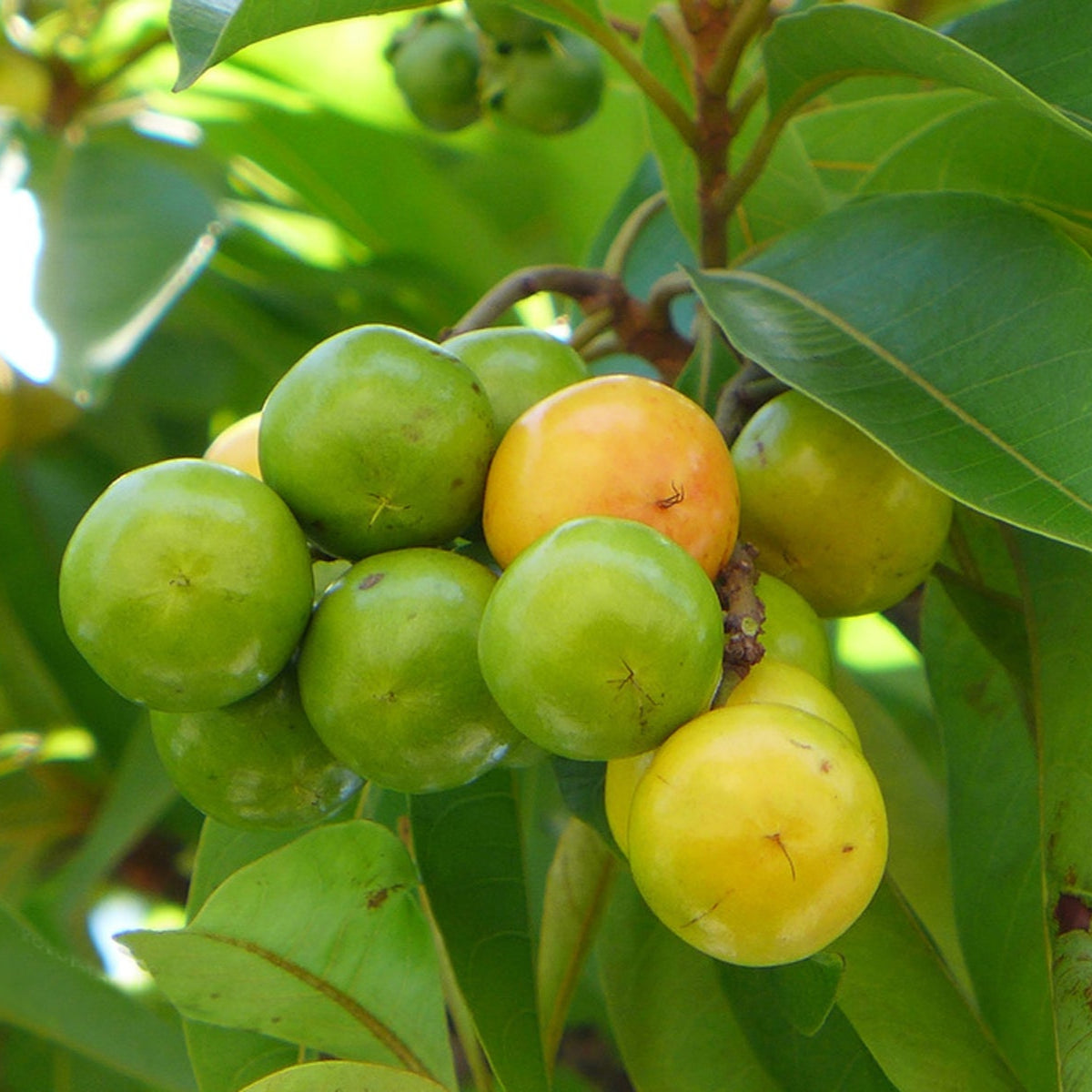Love it? Add to your wishlist
Your favorites, all in one place. Shop quickly and easily with the wishlist feature!
[message]
[title]
[message]




Veliyath Gardens
Couldn't load pickup availability
Botanical Name: Byrsonima crassifolia
Common Names: Yellow Nance, Nance Fruit Tree, Craboo, Nanche, Golden Cherry, Golden Spoon, Yellow Cherry
Native to the sun-drenched landscapes of Central and South America, the Yellow Nance fruit tree (Byrsonima crassifolia) is a striking presence in tropical ecosystems. It thrives from southern Mexico through Central America and reaches deep into Peru and Brazil. In countries like Costa Rica, Panama, and Mexico, Nance has long been a part of the local food culture and natural medicine systems.
This small, golden fruit, often found growing in the wild or in home gardens, holds both nutritional and nostalgic value for communities across the region.
Plant Type: A large shrub or small tree, often branching low and forming a broad canopy.
Height: Can grow up to 10 meters, though typically remains between 4–7 meters in managed gardens.
Leaves: Leathery, glossy green, providing a pleasant tropical aesthetic.
Bloom Time & Fruiting: Begins to bloom and bear fruit typically 3–4 years after planting.
Soil Preference: Adaptable to a variety of soils, including poor or sandy substrates.
Sunlight Requirements: Thrives in full sun with moderate water needs.
Maintenance Level: Moderate; occasional pruning and organic fertilization support healthy growth.
The plant is resilient and often found in dry tropical climates, making it a reliable fruit bearer in diverse garden conditions.
Color & Appearance: Clusters of small, round fruits turn from green to a radiant yellow-golden hue as they ripen.
Texture: Soft and juicy with an oily white pulp.
Seeds: Contains 1–3 small, hard seeds that are not edible.
Taste: A complex blend—often described as a cheesy sweetness, with hints of banana, pear, and lychee. This exotic mix of flavor makes it truly unique.
In Panama and Costa Rica, Nance is made into "chicha de nance", a fermented fruit drink enjoyed during local festivals.
In Mexico, it’s a popular ingredient in ice creams, jams, preserves, and fruit salads.
The ripe fruits are also fermented into liqueurs or cooked down with sugar for syrupy desserts.
The unusual taste has made it a beloved seasonal delicacy, especially in rural communities.
Nance adds a tropical punch to your daily life—whether eaten fresh, blended into drinks, or turned into a memorable homemade dessert.
This golden berry is more than just a culinary treat—it’s packed with beneficial nutrients and antioxidants:
Vitamin C: Strengthens immunity, helps collagen formation, and boosts skin health.
Calcium & Phosphorus: Supports bone health and muscle function.
Dietary Fiber: Promotes digestion and aids in detoxification.
Manganese: Important for enzyme function and bone development.
Tannins & Oxalic Acid: Present in the bark and unripe fruit, used in traditional remedies for skin and intestinal conditions.
Regular intake of Nance fruit may help reduce risks associated with stroke, cardiovascular disease, and oxidative stress. In folk medicine, the bark and fruit are used for treating diarrhea and skin infections.
Spacing: Requires moderate space due to its spreading habit.
Watering: Drought-tolerant once established, but regular watering improves fruit yield.
Fertilization: Apply organic compost twice a year for better flowering and fruiting.
Pests/Diseases: Relatively pest-resistant, especially when grown in well-drained soil.
For home gardeners and tropical plant lovers, the Nance plant is a rewarding addition that brings both ornamental beauty and nutritious fruit.
Fresh: Fruits stay good for 3–5 days after harvest if kept cool.
Fermented: Commonly turned into traditional beverages or liquors.
Preserved: Can be made into jams, jellies, or bottled in syrup for long-term use.
Drying: Sun-drying enhances sweetness and preserves for later use in cooking.
Preserving Nance fruit not only extends its usability but also helps you enjoy its taste year-round.
In Guatemala, Nance is believed to cleanse the stomach and promote appetite.
In El Salvador, it’s used in rural medicine for treating skin irritations and fevers.
The tree also plays a role in reforestation programs due to its hardiness and ecological value.
Locals associate the fruit with childhood memories, seasonal harvests, and cultural pride—making it a plant of emotional as well as nutritional worth.
Exotic Appeal: The plant stands out in any fruit garden with its golden clusters and aromatic presence.
Multipurpose Use: From fresh eating to medicinal use to traditional drinks, Nance offers diversity in your home.
Resilience: With modest care, the tree produces yearly fruit in abundance.
Healthful Delight: It is a guilt-free indulgence packed with vitamins and antioxidants.
Whether you’re a passionate gardener, a tropical fruit enthusiast, or someone seeking something out of the ordinary, the Yellow Nance Fruit Plant (Byrsonima crassifolia) delivers on all fronts. Its vibrant fruits, fascinating taste, and cultural roots make it more than just a plant—it becomes a story in your garden.
At Veliyath Gardens, we grow and offer live Yellow Nance plants, ready to flourish in your home garden. Bring home this tropical wonder and let its golden fruits become part of your daily wellness and culinary journey.
Plant the golden glow of the tropics—discover the joy of Yellow Nance today.
Spacing: Requires moderate space due to its spreading habit.
Watering: Drought-tolerant once established, but regular watering improves fruit yield.
Fertilization: Apply organic compost twice a year for better flowering and fruiting.
Vitamin C: Strengthens immunity, helps collagen formation, and boosts skin health.
Calcium & Phosphorus: Supports bone health and muscle function.
Dietary Fiber: Promotes digestion and aids in detoxification.
Manganese: Important for enzyme function and bone development.
Exotic Appeal: The plant stands out in any fruit garden with its golden clusters and aromatic presence.
Multipurpose Use: From fresh eating to medicinal use to traditional drinks, Nance offers diversity in your home.
Resilience: With modest care, the tree produces yearly fruit in abundance.





